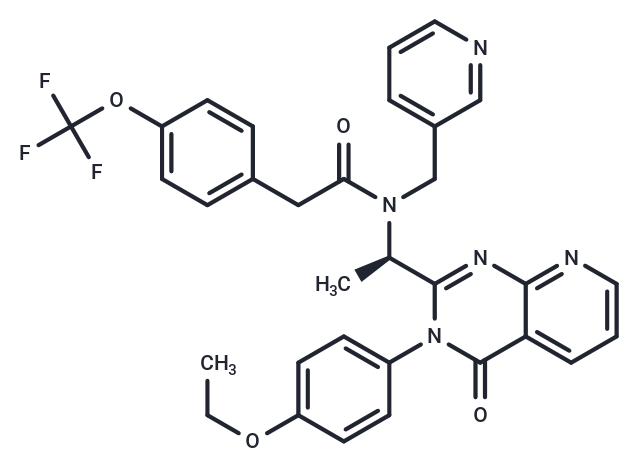Shopping Cart
Remove All Your shopping cart is currently empty
Your shopping cart is currently empty
AMG 487 is a potent and selective antagonist of chemokine (C-X-C motif) receptor 3 (CXCR3) which inhibits the binding of CXCL10 and CXCL11 to CXCR3 with IC50s of 8.0 and 8.2 nM, respectively.

| Pack Size | Price | USA Warehouse | Global Warehouse | Quantity |
|---|---|---|---|---|
| 1 mg | $46 | In Stock | In Stock | |
| 5 mg | $111 | In Stock | In Stock | |
| 10 mg | $159 | In Stock | In Stock | |
| 25 mg | $262 | In Stock | In Stock | |
| 50 mg | $370 | In Stock | In Stock | |
| 100 mg | $587 | In Stock | In Stock | |
| 200 mg | $835 | - | In Stock | |
| 1 mL x 10 mM (in DMSO) | $148 | In Stock | In Stock |
| Description | AMG 487 is a potent and selective antagonist of chemokine (C-X-C motif) receptor 3 (CXCR3) which inhibits the binding of CXCL10 and CXCL11 to CXCR3 with IC50s of 8.0 and 8.2 nM, respectively. |
| Targets&IC50 | [125I]-ITAC-CXCR3:8.2 nM, [125I]-IP10-CXCR3:8 nM |
| In vitro | AMG487 is a small molecular weight antagonist of CXCR3. 66.1 tumor cells were pretreated with AMG487 prior to i.v. injection into immune-competent female mice. Antagonism of CXCR3 on 66.1 tumor cells inhibited experimental lung metastasis, and this antimetastatic activity was compromised in mice depleted of natural killer cells. Systemic administration of AMG487 also inhibited experimental lung metastasis. In contrast to the antimetastatic effect of AMG487, local growth of 66.1 mammary tumors was not affected by receptor antagonism. Murine mammary tumor cells express CXCR3 which facilitates the development of lung metastases.Indicate for the first time that a small molecular weight antagonist of CXCR3 has the potential to inhibit tumor metastasis[2].
|
| In vivo | AMG487, a small molecular weight antagonist. In vivo, systemic CXCR3 antagonism by preventive or curative treatments with AMG487 markedly inhibited the implantation and the growth of human and mouse CRC cells within lung without affecting that in the liver. In addition, we measured increased levels of CXCR3 and ligands expression within lung nodules compared with liver tumours. Activation of CXCR3 receptors by its cognate ligands facilitates the implantation and the progression of CRC cells within lung tissues and that inhibition of this axis decreases pulmonary metastasis of CRC in two murine tumour models[3].
|
| Molecular Weight | 603.59 |
| Formula | C32H28F3N5O4 |
| Cas No. | 473719-41-4 |
| Smiles | CCOc1ccc(cc1)-n1c(nc2ncccc2c1=O)[C@@H](C)N(Cc1cccnc1)C(=O)Cc1ccc(OC(F)(F)F)cc1 |
| Relative Density. | no data available |
| Storage | store at low temperature,keep away from direct sunlight,keep away from moisture | Powder: -20°C for 3 years | In solvent: -80°C for 1 year | Shipping with blue ice/Shipping at ambient temperature. | ||||||||||||||||||||||||||||||
| Solubility Information | DMSO: 41 mg/mL (67.93 mM), Sonication is recommended. | ||||||||||||||||||||||||||||||
| In Vivo Formulation | 10% DMSO+40% PEG300+5% Tween 80+45% Saline: 2 mg/mL (3.31 mM), Sonication is recommended. Please add the solvents sequentially, clarifying the solution as much as possible before adding the next one. Dissolve by heating and/or sonication if necessary. Working solution is recommended to be prepared and used immediately. The formulation provided above is for reference purposes only. In vivo formulations may vary and should be modified based on specific experimental conditions. | ||||||||||||||||||||||||||||||
Solution Preparation Table | |||||||||||||||||||||||||||||||
DMSO
| |||||||||||||||||||||||||||||||
| Size | Quantity | Unit Price | Amount | Operation |
|---|

Copyright © 2015-2025 TargetMol Chemicals Inc. All Rights Reserved.